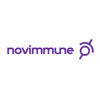预约演示
更新于:2025-05-07
Lamkap Bio Alpha AG
私营公司|Switzerland
私营公司|Switzerland
更新于:2025-05-07
概览
标签
肿瘤
消化系统疾病
双特异性抗体
双特异性T细胞结合器
疾病领域得分
一眼洞穿机构专注的疾病领域
暂无数据
技术平台
公司药物应用最多的技术
暂无数据
靶点
公司最常开发的靶点
暂无数据
| 疾病领域 | 数量 |
|---|---|
| 肿瘤 | 2 |
| 排名前五的药物类型 | 数量 |
|---|---|
| 双特异性T细胞结合器 | 1 |
| 双特异性抗体 | 1 |
| 排名前五的靶点 | 数量 |
|---|---|
| CD3ε x CEACAM5 | 1 |
| CD47 x CEA | 1 |
关联
2
项与 Lamkap Bio Alpha AG 相关的药物作用机制 CD3ε agonists [+1] |
原研机构 |
非在研适应症- |
最高研发阶段临床1期 |
首次获批国家/地区- |
首次获批日期- |
作用机制 CD47抑制剂 [+3] |
原研机构 |
在研适应症 |
非在研适应症- |
最高研发阶段临床前 |
首次获批国家/地区- |
首次获批日期- |
100 项与 Lamkap Bio Alpha AG 相关的临床结果
登录后查看更多信息
0 项与 Lamkap Bio Alpha AG 相关的专利(医药)
登录后查看更多信息
2
项与 Lamkap Bio Alpha AG 相关的文献(医药)Journal of Hematology & Oncology
Development and characterization of NILK-2301, a novel CEACAM5xCD3 κλ bispecific antibody for immunotherapy of CEACAM5-expressing cancers
Article
作者: Krämer, Sebastian ; Malinge, Pauline ; Poitevin, Yves ; Magistrelli, Giovanni ; Kallendrusch, Sonja ; Nouveau, Lise ; Lordick, Florian ; Calloud, Sebastien ; Papaioannou, Anne ; Chatel, Laurence ; Gockel, Ines ; Salgado-Pires, Susana ; Ngoc, Hoang ; Moine, Valéry ; Cons, Laura ; Daubeuf, Bruno ; Lesnier, Adeline ; Ravn, Ulla ; Strein, Klaus ; Hose, Dirk ; Majocchi, Sara ; Broyer, Lucile ; Seckinger, Anja ; Pleche, Nicolas ; Masternak, Krzysztof ; Shang, Limin
Journal of Hematology & Oncology
Development and characterization of NILK-2301, a novel CEACAM5xCD3 κλ bispecific antibody for immunotherapy of CEACAM5-expressing cancers
作者: Kallendrusch, Sonja ; Lesnier, Adeline ; Calloud, Sebastien ; Poitevin, Yves ; Magistrelli, Giovanni ; Ngoc, Hoang ; Hose, Dirk ; Gockel, Ines ; Daubeuf, Bruno ; Malinge, Pauline ; Papaioannou, Anne ; Masternak, Krzysztof ; Shang, Limin ; Strein, Klaus ; Pleche, Nicolas ; Cons, Laura ; Chatel, Laurence ; Ravn, Ulla ; Salgado-Pires, Susana ; Broyer, Lucile ; Seckinger, Anja ; Moine, Valery ; Majocchi, Sara ; Kramer, Sebastian ; Lordick, Florian ; Nouveau, Lise
100 项与 Lamkap Bio Alpha AG 相关的药物交易
登录后查看更多信息
100 项与 Lamkap Bio Alpha AG 相关的转化医学
登录后查看更多信息
组织架构
使用我们的机构树数据加速您的研究。
登录
或

管线布局
2026年01月07日管线快照
管线布局中药物为当前组织机构及其子机构作为药物机构进行统计,早期临床1期并入临床1期,临床1/2期并入临床2期,临床2/3期并入临床3期
临床前
2
登录后查看更多信息
当前项目
| 药物(靶点) | 适应症 | 全球最高研发状态 |
|---|---|---|
NILK-2301 ( CD3ε x CEACAM5 ) | 肿瘤 更多 | 临床前 |
NI-2401 ( CD47 x CEA ) | 实体瘤 更多 | 临床前 |
登录后查看更多信息
药物交易
使用我们的药物交易数据加速您的研究。
登录
或

转化医学
使用我们的转化医学数据加速您的研究。
登录
或

营收
使用 Synapse 探索超过 36 万个组织的财务状况。
登录
或

科研基金(NIH)
访问超过 200 万项资助和基金信息,以提升您的研究之旅。
登录
或

投资
深入了解从初创企业到成熟企业的最新公司投资动态。
登录
或

融资
发掘融资趋势以验证和推进您的投资机会。
登录
或

生物医药百科问答
全新生物医药AI Agent 覆盖科研全链路,让突破性发现快人一步
立即开始免费试用!
智慧芽新药情报库是智慧芽专为生命科学人士构建的基于AI的创新药情报平台,助您全方位提升您的研发与决策效率。
立即开始数据试用!
智慧芽新药库数据也通过智慧芽数据服务平台,以API或者数据包形式对外开放,助您更加充分利用智慧芽新药情报信息。
生物序列数据库
生物药研发创新
免费使用
化学结构数据库
小分子化药研发创新
免费使用
